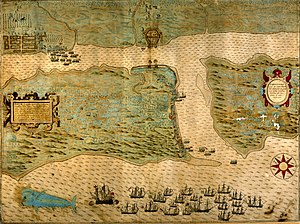| Raid on St. Augustine | |||||||||
|---|---|---|---|---|---|---|---|---|---|
| Part of the Anglo–Spanish War | |||||||||
 Sir Francis Drake in St. Augustine 1586 hand-colored engraving, by Baptista Boazio, 1589 | |||||||||
| |||||||||
| Belligerents | |||||||||
|
|
| ||||||||
| Commanders and leaders | |||||||||
| Governor Pedro Menéndez de Márquez |
Sir Francis Drake Christopher Carleill | ||||||||
| Strength | |||||||||
|
100 soldiers & militia Unknown number of Indians 2 forts[2] |
23 ships, 19 support vessels & prizes, 1,000 troops[3] | ||||||||
| Casualties and losses | |||||||||
| 35 killed or wounded[4] | Light | ||||||||
The Raid on St. Augustine was a military event during the Anglo-Spanish War in which the Spanish settlement of St. Augustine in Florida (Spanish: San Agustín)) was captured in a small fight and burnt by an English expedition fleet led by Sir Francis Drake.[1] This was part of Sir Francis Drake's Great Expedition and was his last engagement on the Spanish Main before he headed north for the Roanoke Colony. The expedition also forced the Spanish to abandon any settlements and forts in present-day South Carolina.